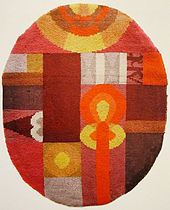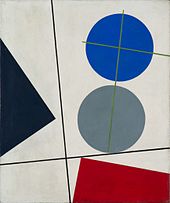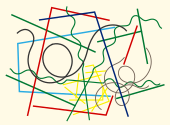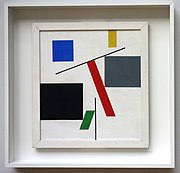Sophie Taeuber-Arp
Sophie Taeuber-Arp | |
|---|---|
Concrete Art, Constructivism, Dada | |
| Spouse | Jean Arp |
Sophie Henriette Gertrud Taeuber-Arp (
Born in 1889 in Davos and raised in Trogen, Switzerland, she attended a trade school in St. Gallen and, later, art schools in Germany, before moving back to Switzerland during the First World War. At an exhibition in 1915, she met for the first time the German-French artist Jean Arp,[2] whom she married shortly after. It was during these years that they became associated with the Dada movement, which emerged in 1916, and Taeuber-Arp's most famous works – Dada Head (Tête Dada; 1920) – date from these years.[3] They moved to France in 1926, where they stayed until the invasion of France during the Second World War, at the event of which they went back to Switzerland. In 1943, she died in an accident with a leaking gas stove.[2]
Despite being overlooked since her death,[4] she is considered one of the most important artists of concrete art and geometric abstraction of the 20th century.
Early life
Born in Davos, Switzerland, Sophie Henriette Gertrud Taeuber was the fifth child of Prussian pharmacist Emil Taeuber and Swiss Sophie Taeuber-Krüsi, from Gais in Appenzell Ausserrhoden, Switzerland. Her parents operated a pharmacy in Davos until her father died of tuberculosis when she was two years old, after which the family moved to Trogen, where her mother opened a pension. She was taught to sew by her mother.[5]
She studied textile design at the trade school (Gewerbeschule, today School of Applied Arts) in
Dada



In 1915, at an exhibition at the Tanner Gallery, she met the
Taeuber-Arp taught weaving and other textile arts at the
During this period, she was involved in the Zürich Dada movement, which centred on the Cabaret Voltaire.[6] She took part in Dada-inspired performances as a dancer, choreographer, and puppeteer, and she designed puppets,[2] costumes and sets for performances at the Cabaret Voltaire as well as for other Swiss and French theatres. At the opening of the Galerie Dada in 1917, she danced to poetry by Hugo Ball while wearing a shamanic mask by Marcel Janco.[11] A year later, she was a co-signer of the Zürich Dada Manifesto.[12] As both a dancer and painter, Taeuber was able to incorporate Dada in her movement for dancing and was described as obscure and awkward.[13]
She also made a number of sculptural works, such as a set of abstract "Dada Heads" of turned polychromed wood. With their witty resemblance to the ubiquitous small stands used by hatmakers, they typified her elegant synthesis of the fine and applied arts.[14]
Taeuber-Arp was also a close friend and contemporary of the French-Romanian avant-garde poet, essayist, and artist, Tristan Tzara, one of the central figures of the Dada movement. In 1920, Tzara solicited over four dozen Dadaist artists, among which were Taeuber-Arp, Jean Arp, Jean Cocteau, Marcel Duchamp, and Hannah Höch. Tzara planned to use the contributed text and images to create an anthology of Dada work entitled Dadaglobe. A worldwide release of 10,000 copies was planned, but the project was abandoned when its main backer, Francis Picabia, distanced himself from Tzara in 1921.[15]
The Guardian called her a "radical artist who brought joy to the dada". Though dada has been described as an early form of subversive pop culture likened by some to the punk subculture, critics have said that Taeuber's artworks were not angry but "joyous abstractions", created as part of a movement that has been called revolutionary for its influence challenging the established conventions of art by "playing with blocks and blobs of colour, moving them around randomly, letting patterns emerge by chance, in a kind of visual jazz."[16]
France


In 1926 Taeuber-Arp and Jean Arp moved to Strasbourg, where both took up French citizenship; after which they divided their time between Strasbourg and Paris. There Taeuber-Arp received numerous commissions for interior design projects; for example, she was commissioned to create a radically Constructivist interior for the Café de l'Aubette – a project on which Jean Arp and de Stijl artist Theo van Doesburg eventually joined her as collaborators. In 1927 she co-authored a book entitled Welly Lowell with Blanche Gauchet.[10]
From the late 1920s, she lived mainly in Paris and continued experimenting with design. The couple became French citizens in 1926[7] and in 1928 they moved to Meudon/Val-Fleury, outside Paris, where she designed their new house and some of its furnishings.[17] She was an exhibitor at the Salon des surindépendents in Paris in 1929–30.
In the 1930s, she was a member of the group
Sophie Taeuber-Arp explored the circle which represented the cosmic metaphor, the form that contains all others. She referred to this period as “ping pictures”.[19]
She appears to be the first artist to use polka dots in fine art with works such as Dynamic Circles, 1934, in the footsteps of Kazimir Malevich and his Black Circle (1915).
Later in the decade she founded a Constructivist review, Plastique (Plastic) in Paris. Her circle of friends included the artists Sonia Delaunay, Robert Delaunay, Wassily Kandinsky, Joan Miró, and Marcel Duchamp.[10] She was also a member of Allianz, a union of Swiss painters, from 1937 to 1943.[7] In 1940, Taeuber-Arp and Arp fled Paris ahead of the Nazi occupation and moved to Grasse in Vichy France, where they created an art colony with Sonia Delaunay, Alberto Magnelli, and other artists. At the end of 1942, they fled to Switzerland.
Death and legacy
In early 1943, Taeuber-Arp missed the last tram home one night and slept in a snow-covered summer house.[5] She died there of accidental carbon monoxide poisoning caused by an incorrectly operated stove at the house of Max Bill.[10]
Wassily Kandinsky said: "Sophie Taeuber-Arp expressed herself by means of the 'colored relief,' especially in the last years of her life, using almost exclusively the simplest forms, geometric forms. The forms, by their sobriety, their silence, their way of being sufficient unto themselves, invite the hand, if it is skillful, to use the language that is suitable to it and which is often only a whisper; but often too the whisper is more expressive, more convincing, more persuasive, than the 'loud voice' that here and there lets itself burst out."[20]
In 2014, at the Danser sa vie dance and art exhibition at the
Taeuber-Arp was the only woman on the eighth series of Swiss banknotes; her portrait was on the 50-franc note from 1995 to 2016.[10]
A museum honouring[22] Taeuber-Arp and Jean Arp opened in 2007 in a section of the Rolandseck railway station in Germany, re-designed by Richard Meier.[10] The video work "Sophie Taeuber-Arp's Vanishing Lines" (2015) by new media artist Myriam Thyes from Switzerland is about her "Lignes" drawings, segmented circles intersected by lines.[23][24]
On 19 January 2016, Google created a Google Doodle for Taeuber-Arp to commemorate her 127th birthday. The doodle was made by Mark Holmes.[25][26][27]
Exhibitions
Taeuber-Arp took part in numerous exhibitions. For example, she was included in the first Carré exhibition at the Galeries 23 (Paris) in 1930, along with other notable early 20th-century modernists. In 1943, Taeuber-Arp was included in
In 1970, an exhibit of Taeuber-Arp's work was shown at the Albert Loeb Gallery in New York City.[29]
Then, in 1981 the
American scholar Adrian Sudhalter organized an exhibition called "Dadaglobe Reconstructed" that sought to honor the centennial of Dada's inception, along with Tzara's ambitious project. Compiling over 100 works of art that were initially slated to appear in Tristan Tzara's Dadaglobe anthology, among which are works by Taeuber-Arp, the show ran from 5 February to 1 May 2016 at the Kunsthaus Zürich, and from 12 June to 18 September 2016 at the Museum of Modern Art in New York City.[30]
In 2020, Hauser & Wirth opened an online exhibition devoted to her work, the first in a series of international exhibitions devoted to her career.[4][3]
As of July 2020, a coordinated travelling retrospective of her work is scheduled to open in March 2021 at the
Gallery
-
Composition with Diagonals and Circle, painting, 1916
-
Vertical-Horizontal Composition, textile, 1916
-
Coupe Dada, sculpture, 1916
-
Arch pattern composition, gouache on paper, 1918
-
Dada Composition (Tête au plat), painting, 1920
-
Tête Dada, wood sculpture, 1920
-
Dada carpet, 1920
-
Abstract composition, stained glass, 1926–27
-
Composition r, gouache on paper, 1931
-
Quatre espaces à croix brisée, oil on canvas, 1932
-
Balance, 1932-1933
Bibliography
- Andreas Kotte, ed. (2005). "Sophie Taeuber-Arp". OCLC 62309181.
- Sophie Taeuber-Arp 1889–1943. Catalogue of the exhibition in the Arp-Museum Bahnhof Rolandseck, at the Kunsthalle Tübingen (1993), at the Städtischen Galerie im Lenbachhaus München (1994). publisher: ISBN 3-7757-0419-1
- Gabriele Mahn: "Sophie Taeuber-Arp", pp. 160–168, in: Karo Dame, book on the exhibition Karo Dame. Konstruktive, Konkrete und Radikale Kunst von Frauen von 1914 bis heute, ISBN 3-906700-95-X
- Christoph Vögele. Variations. Sophie Taeuber-Arp. Arbeiten auf Papier. Book on the exhibition at the Kunstmuseum Solothurn. Heidelberg: Kehrer Verlag, 2002. ISBN 3-933257-90-5
- Sophie Taeuber-Arp – Gestalterin, Architektin, Tänzerin. Catalogue of the exhibition at the Museum Bellerive, Zürich. publisher: Hochschule für Gestaltung und Kunst Zürich. Zürich: Verlag Scheidegger & Spiess, 2007. ISBN 978-3-85881-196-7
- Bewegung und Gleichgewicht. Sophie Taeuber-Arp 1889–1943. Book on the exhibition at the Kirchner Museum Davos and at the Arp Museum Bahnhof Rolandseck. editor: Karin Schick, Oliver Kornhoff, Astrid von Asten. Bielefeld: Kerber Verlag, 2010. ISBN 978-3-86678-320-1
- Susanne Meyer-Büser: "Zwei Netzwerkerinnen der Avantgarde in Paris um 1930. Auf den Spuren von Florence Henri und Sophie Taeuber-Arp", in: Die andere Seite des Mondes. Künstlerinnen der Avantgarde. Book on the exhibition at the Kunstsammlung Nordrhein-Westfalen, Düsseldorf (ed.), and at the Louisiana Museum of Modern Art, Humlebaek, Dänemark. Köln: DuMont Buchverlag, 2011. ISBN 978-3-8321-9391-1
- Roswitha Mair: Handwerk und Avantgarde. Das Leben der Künstlerin Sophie Taeuber-Arp. Berlin: Parthas Verlag, 2013. ISBN 978-0-226-31121-0.
- Sophie Taeuber-Arp – Heute ist Morgen. Comprehensive publication on the exhibition at the Aargauer Kunsthaus, Aarau, and at the Kunsthalle Bielefeld. Editor: Thomas Schmutz und Aargauer Kunsthaus, Friedrich Meschede und Kunsthalle Bielefeld. Zürich: Verlag Scheidegger & Spiess, 2014. ISBN 978-3-85881-432-6
- West, Shearer (1996). The Bullfinch Guide to Art. UK: Bloomsbury Publishing Plc. ISBN 0-8212-2137-X.
- Schmidt, Georg, ed. (1948). Sophie Taeuber-Arp, Holbein Verlag.
- Vgele, Christoph, and Walburga Krupp (2003). Sophie Taeuber-Arp: Works on Paper, Kehrer Verlag.
References
- ^ Bucher, Annemarie. "SophieTaeuber-Arp". Historiches Lexikon der Schweiz [Historical Dictionary of Switzerland] (in German).
- ^ a b c d Kennicott, Philip (31 December 2021). "Sophie Taeuber-Arp could make just about anything. That meant a complicated legacy. A new exhibition at the Museum of Modern Art shows the artist's range, if not who she really was". Washington Post. Retrieved 5 January 2022.
- ^ a b c d "Sophie Taeuber-Arp: Online Exhibition". Hauser & Wirth. Retrieved 16 July 2020.
- ^ a b c d Loos, Ted (9 July 2020). "A Swiss Dada Pioneer Finally Gets Her Spotlight". The New York Times. Retrieved 16 July 2020.
- ^ a b "Sophie Taeuber-Arp review – the great overlooked modernist". The Guardian. 18 July 2021. Retrieved 5 September 2021.
- ^ ISBN 978-1-4422-3352-2.
- ^ ISBN 978-1-136-59901-9.
- ISBN 978-0-912964-31-7.
- S2CID 192473148.
- ^ ISBN 978-3-86964-047-1.
- ^ Tate. "Five Things to Know About Sophie Taeuber-Arp – List". Tate. Retrieved 5 September 2021.
- ISBN 978-1-884550-21-8.
- S2CID 191510522.
- ISBN 978-0-8109-6916-2.
- ISSN 0362-4331. Retrieved 11 March 2017.
- ^ "Sophie Taeuber-Arp: it's about time the radical dada star got a Google doodle". The Guardian. 19 January 2016. Retrieved 25 July 2019.
- New York Times.
- ^ Taeuber-Arp, Sophie (February 1933). "Untitled cover art". Transition (22): front and back cover.
- ISBN 0-87070-598-9.
- ^ Lanchner, Carolyn (1981). "Sophie Taeuber-Arp" (PDF). The Museum of Modern Art. Retrieved 21 February 2019.
- ^ "Dada Dance: Sophie Taeuber's Visceral Abstraction – Art Journal Open". Art Journal Open. 3 July 2014. Retrieved 11 March 2017.
- ^ arp museum. "Hans Arp and Sophie Taeuber-Arp". Retrieved 27 October 2016.
- ^ Schaumbad – Freies Atelierhaus Graz. "100 Years of World Transition". Retrieved 27 October 2016.
- ^ Myriam Thyes. "Sophie Taeuber-Arp's Vanishing Lines". Retrieved 27 October 2016.
- ^ Parsons, Jeff (19 January 2016). "Who was Sophie Taeuber-Arp and why is she the subject of today's Google doodle?". mirror. Retrieved 11 March 2017.
- ^ Rhiannon Williams (19 January 2016). "Who was Sophie Taeuber-Arp? One of the most influential female artists you've probably never heard of". The Daily Telegraph. Retrieved 19 January 2016.
- ^ "Sophie Taeuber-Arp's 127th Birthday". google.com.
- ISBN 978-0-87070-771-1.
- ^ Kramer, Hilton (18 October 1970). "Taeuber-Arp and Albers: Loyal Only to Art - NYTimes.com". The New York Times. Retrieved 11 March 2017.
- ^ "Dadaglobe Reconstructed". The Museum of Modern Art. Retrieved 11 March 2017.
- ^ a b "Sophie Taeuber-Arp". Tate. Retrieved 7 July 2020.
- ^ "Sophie Taruber-Arp: Living Abstraction". MoMA. Retrieved 16 July 2020.
- ^ Esplund, Lance (25 December 2021). "'Sophie Taeuber-Arp: Living Abstraction' Review: Celebrating Abstract Art as It Was Meant to Be". WSJ. Retrieved 5 January 2022.
- Taeuber-Arp collection at Museum of Modern Art
- Sophie Taeuber-Arp in American public collections, on the French Sculpture Census website
- Wagner, Anne (6 December 2018). "My wife brandishes circle and line". London Review of Books. 40 (23). Retrieved 13 December 2018. Book review of Mair, Roswitha (2018). Sophie Taeuber-Arp and the avant-garde : a biography. Chicago: The University of Chicago Press. ISBN 978-3-86964-047-1.
External links
 Media related to Sophie Taeuber-Arp at Wikimedia Commons
Media related to Sophie Taeuber-Arp at Wikimedia Commons Quotations related to Sophie Taeuber-Arp at Wikiquote
Quotations related to Sophie Taeuber-Arp at Wikiquote- Sophie Taeuber-Arp - 26 obras de arte - pintura
- Sophie Taeuber-Arp Research Project (STARP) - a project of the Stiftung Arp e. V. (Remagen/Berlin) and the Gerhard-Marcks-Haus (Bremen)












